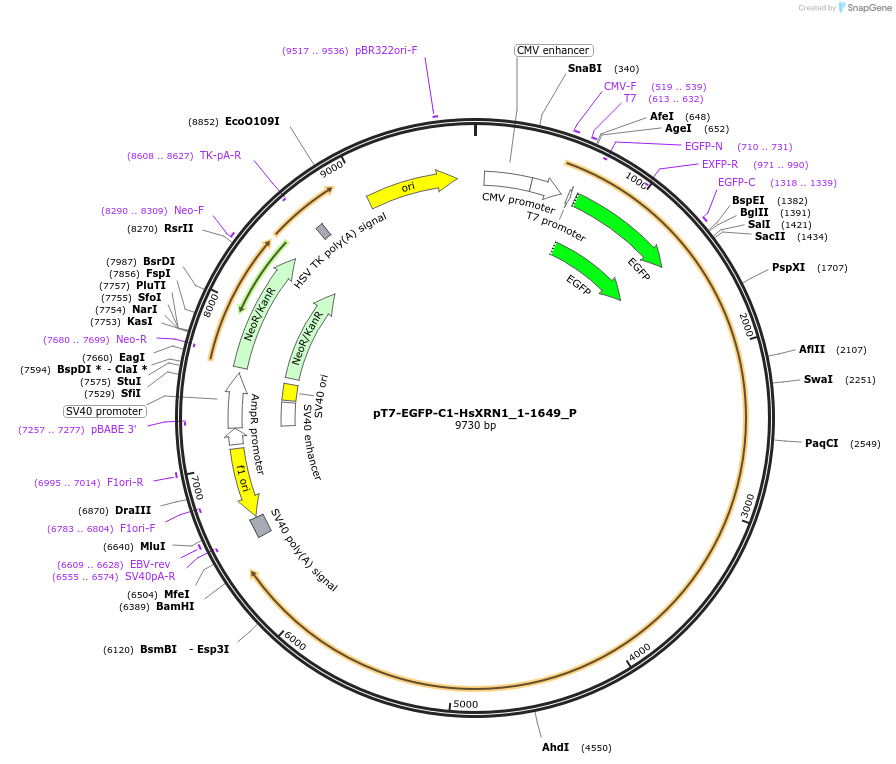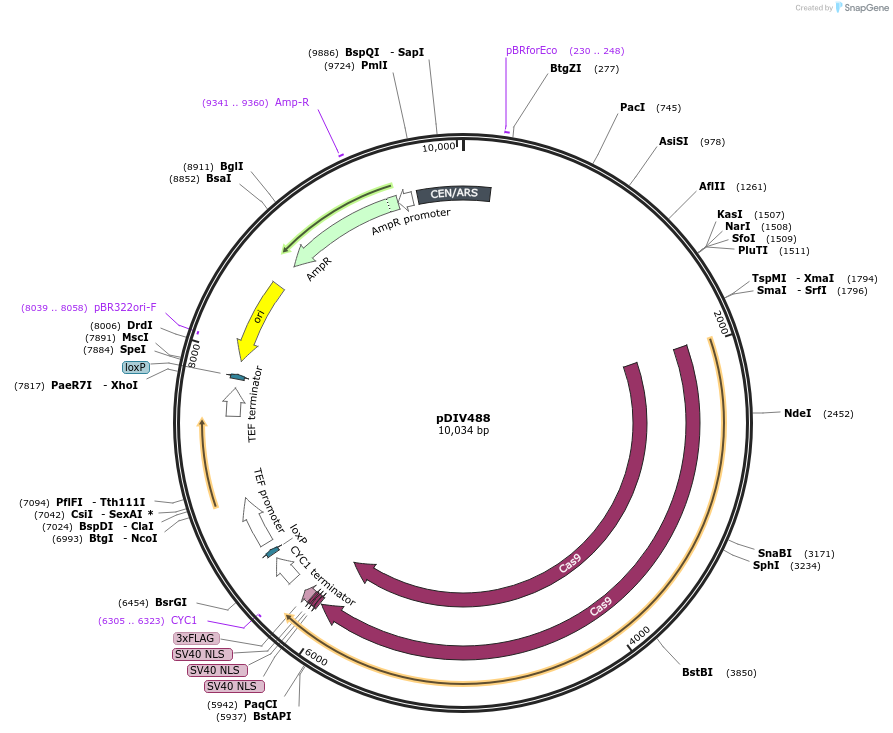We narrowed to 19,963 results for: omp
-
Plasmid#147248PurposeMammalian Expression of HsXRN1_1-1649DepositorInsertHsXRN1_1-1649 (XRN1 Human)
ExpressionMammalianMutationone silent mutation compared to the sequence give…Available SinceMarch 16, 2023AvailabilityAcademic Institutions and Nonprofits only -
pAc5.1B-lambdaN-HA-CePAN3_O
Plasmid#147149PurposeInsect Expression of CePAN3DepositorInsertCePAN3
ExpressionInsectMutationInsertion of two AA (FQ) at position 172 and one …Available SinceMarch 16, 2023AvailabilityAcademic Institutions and Nonprofits only -
pGEX-6P-1-HsTNRC6Biso1_1379-1723del1535-1624_P
Plasmid#147204PurposeBacterial Expression of HsTNRC6Biso1_1379-1723del1535-1624DepositorInsertHsTNRC6Biso1_1379-1723del1535-1624 (TNRC6B Human)
ExpressionBacterialMutationone non silent mutation T1486A compared to the se…Available SinceMarch 16, 2023AvailabilityAcademic Institutions and Nonprofits only -
pT7-EGFP-C1-HsTNRC6Biso1 1-1218_L
Plasmid#146887PurposeMammalian Expression of HsTNRC6Biso1_1-1218DepositorInsertHsTNRC6Biso1_1-1218 (TNRC6B Human)
ExpressionMammalianMutation4 non silent mutations, S441G, H1088R, Q1106R, Q1…Available SinceMarch 16, 2023AvailabilityAcademic Institutions and Nonprofits only -
pT7-EGFP-C1-HsTNRC6Biso1_1218-1723_L
Plasmid#146888PurposeMammalian Expression of HsTNRC6Biso1_1218-1723DepositorInsertHsTNRC6Biso1_1218-1723 (TNRC6B Human)
ExpressionMammalianMutationone non silent mutation T1486A and a deletion of …Available SinceMarch 16, 2023AvailabilityAcademic Institutions and Nonprofits only -
pLNHA-C1-HsNot1iso2_J
Plasmid#146696PurposeMammalian Expression of HsNot1iso2DepositorInsertHsNot1iso2 (CNOT1 Human)
ExpressionMammalianMutation4 silent and two non silent G917E and R2353Q muta…Available SinceMarch 16, 2023AvailabilityAcademic Institutions and Nonprofits only -
pAc5.1B-lambdaN-HA-DmNot1_1963-2505-dsRNAres_AC
Plasmid#148403PurposeInsect Expression of Dmot1_1963-2502-dsRNAresDepositorInsertDmot1_1963-2502-dsRNAres
ExpressionInsectMutation2 silent mutations compared to the sequence given…Available SinceMarch 16, 2023AvailabilityAcademic Institutions and Nonprofits only -
pN1-HsSmg5_267-1017-V5-SBP-MBP_V
Plasmid#147762PurposeMammalian Expression of HsSmg5_267-1017DepositorInsertHsSmg5_267-1017 (SMG5 Human)
ExpressionMammalianMutationone silent mutation C969T compared to the sequenc…Available SinceMarch 16, 2023AvailabilityAcademic Institutions and Nonprofits only -
pN1-HsSmg5-V5-SBP-MBP_V
Plasmid#147768PurposeMammalian Expression of HsSmg5DepositorInsertHsSmg5 (SMG5 Human)
ExpressionMammalianMutationone silent mutation C969T compared to the sequenc…Available SinceMarch 16, 2023AvailabilityAcademic Institutions and Nonprofits only -
pCIneo-lambdaN-HA-HsSmg7_1-633_U
Plasmid#147644PurposeMammalian Expression of HsSmg7_1-633DepositorInsertHsSmg7_1-633 (SMG7 Human)
ExpressionMammalianMutationthree silent mutation G216A, T1185C and A1521G co…Available SinceMarch 16, 2023AvailabilityAcademic Institutions and Nonprofits only -
pcDNA3.1-MS2-HA-HsSmg5-del133-155_T
Plasmid#147553PurposeMammalian Expression of HsSmg5-del133-155DepositorInsertHsSmg5-del133-155 (SMG5 Human)
ExpressionMammalianMutationone silent mutation compared to the sequence give…Available SinceMarch 16, 2023AvailabilityAcademic Institutions and Nonprofits only -
pcDNA3.1-MS2-HA-HsSmg7_1-633_T
Plasmid#147557PurposeMammalian Expression of HsSmg7_1-633DepositorInsertHsSmg7_1-633 (SMG7 Human)
ExpressionMammalianMutationtwo silent mutation G216A, A1521G compared to the…Available SinceMarch 16, 2023AvailabilityAcademic Institutions and Nonprofits only -
pGEX-6P-1-HsSmg6_1-207_K
Plasmid#146755PurposeBacterial Expression of HsSmg6_1-207DepositorInsertHsSmg6_1-207 (SMG6 Human)
ExpressionBacterialMutationone silent mutation compared to the sequence give…Available SinceMarch 16, 2023AvailabilityAcademic Institutions and Nonprofits only -
pAc5.1B-lambdaN-HA-DmGe1_J
Plasmid#146688PurposeInsect Expression of DmGe1DepositorInsertDmGe1 (Ge-1 Fly)
ExpressionInsectMutationtwo non silent mutations Q194R and I1008T compare…Available SinceJan. 13, 2023AvailabilityAcademic Institutions and Nonprofits only -
pDIV492
Plasmid#177700PurposePlasmid expressing optimized Cas9 and NAT marker. Compatible with CTG-clade yeast species.DepositorInsertsCas9
Nat
UseCRISPRTagsSV40ExpressionBacterial and YeastPromoterRHR2p (Debaryomyces hansenii ) and TEF1p (Ashbya …Available SinceJuly 12, 2022AvailabilityAcademic Institutions and Nonprofits only -
pcDNA3.1-MS2-HA-HsSmg5-G120E_W
Plasmid#147819PurposeMammalian Expression of HsSmg5-G120EDepositorInsertHsSmg5-G120E (SMG5 Human)
ExpressionMammalianMutationone silent mutation compared to the sequence give…Available SinceMarch 23, 2022AvailabilityAcademic Institutions and Nonprofits only -
pcDNA3.1-MS2-HA-HsSmg7_633-1091_T
Plasmid#147558PurposeMammalian Expression of HsSmg7_633-1091DepositorInsertHsSmg7_633-1091 (SMG7 Human)
ExpressionMammalianMutationone non silent mutation V854I compared to the seq…Available SinceMarch 17, 2022AvailabilityAcademic Institutions and Nonprofits only -
pDIV491
Plasmid#177699PurposePlasmid expressing optimized Cas9 and NAT marker. Compatible with CTG-clade yeast species.DepositorInsertsCas9
Nat
UseCRISPRTagsSV40ExpressionBacterial and YeastPromoterRNR2p (Debaryomyces hansenii ) and TEF1p (Ashbya …Available SinceMarch 11, 2022AvailabilityAcademic Institutions and Nonprofits only -
pDIV488
Plasmid#177696PurposePlasmid expressing optimized Cas9 and NAT marker. Compatible with CTG-clade yeast speciesDepositorInsertsCas9
Nat
UseCRISPRTagsSV40ExpressionBacterial and YeastPromoterTDH3p (Candida lusitaniae) and TEF1p (Ashbya goss…Available SinceMarch 11, 2022AvailabilityAcademic Institutions and Nonprofits only -
pAc5.1B-lambdaN-HA-DmCup_C
Plasmid#146064PurposeInsect Expression of DmCupDepositorInsertDmCup (cup Fly)
ExpressionInsectMutationTwo silent mutations compared to the sequence giv…Available SinceFeb. 25, 2022AvailabilityAcademic Institutions and Nonprofits only






















